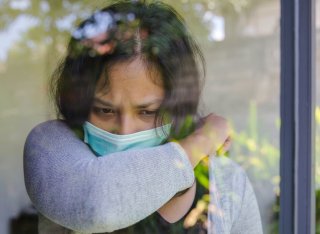
Dr Cecile Frampas
About
My research project
.
.
Publications
The COVID-19 pandemic has led to an unprecedented demand for testing - for diagnosis and prognosis - as well as for investigation into the impact of the disease on the host metabolism. Sebum sampling has the potential to support both needs by looking at what the virus does to us, rather than looking for the virus itself. In this pilot study, sebum samples were collected from 67 hospitalised patients (30 COVID-19 positive and 37 COVID-19 negative) by gauze swab. Lipidomics analysis was carried out using liquid chromatography mass spectrometry, identifying 998 reproducible features. Univariate and multivariate statistical analyses were applied to the resulting feature set. Lipid levels were depressed in COVID-19 positive participants, indicative of dyslipidemia; p-values of 0·022 and 0·015 were obtained for triglycerides and ceramides respectively, with effect sizes of 0·44 and 0·57. Partial Least Squares-Discriminant Analysis showed separation of COVID-19 positive and negative participants with sensitivity of 57% and specificity of 68%, improving to 79% and 83% respectively when controlled for confounding comorbidities. COVID-19 dysregulates many areas of metabolism; in this work we show that the skin lipidome can be added to the list. Given that samples can be provided quickly and painlessly, we conclude that sebum is worthy of future consideration for clinical sampling. The authors acknowledge funding from the EPSRC Impact Acceleration Account for sample collection and processing, as well as EPSRC Fellowship Funding EP/R031118/1, the University of Surrey and BBSRC BB/T002212/1. Mass Spectrometry was funded under EP/P001440/1.
Description This dataset of participant, field blank and quality control liquid-chromatography-mass spectrometry .raw files supports the following article: Changes to the sebum lipidome upon COVID-19 infection observed via rapid sampling from the skin - EClinicalMedicine (thelancet.com) Background The COVID-19 pandemic has led to an unprecedented demand for testing - for diagnosis and prognosis - as well as for investigation into the impact of the disease on the host metabolism. Sebum sampling has the potential to support both needs by looking at what the virus does to us, rather than looking for the virus itself. Methods and attached dataset description In this pilot study, sebum samples were collected from 67 hospitalised patients (30 COVID-19 positive and 37 COVID-19 negative) by gauze swab. Lipidomics analysis was carried out using liquid chromatography mass spectrometry, identifying 998 reproducible features. Univariate and multivariate statistical analyses were applied to the resulting feature set. The dataset uploaded here represents .raw liquid chromatography-mass spectrometry files for participants (triplicate injections), field blanks and pooled quality control standards, as well as the output peak:area matrix. Findings Lipid levels were depressed in COVID-19 positive participants, indicative of dyslipidemia; p-values of 0·022 and 0·015 were obtained for triglycerides and ceramides respectively, with effect sizes of 0·44 and 0·57. Partial Least Squares-Discriminant Analysis showed separation of COVID-19 positive and negative participants with sensitivity of 57% and specificity of 68%, improving to 79% and 83% respectively when controlled for confounding comorbidities. Interpretation COVID-19 dysregulates many areas of metabolism; in this work we show that the skin lipidome can be added to the list. Given that samples can be provided quickly and painlessly, we conclude that sebum is worthy of future consideration for clinical sampling.
Treatments for COVID-19 infections have improved dramatically since the beginning of the pandemic, and glucocorticoids have been a key tool in improving mortality rates. The UK’s National Institute for Health and Care Excellence guidance is for treatment to be targeted only at those requiring oxygen supplementation, however, and the interactions between glucocorticoids and COVID-19 are not completely understood. In this work, a multi-omic analysis of 98 inpatient-recruited participants was performed by quantitative metabolomics (using targeted liquid chromatography-mass spectrometry) and data-independent acquisition proteomics. Both ‘omics datasets were analysed for statistically significant features and pathways differentiating participants whose treatment regimens did or did not include glucocorticoids. Metabolomic differences in glucocorticoid-treated patients included the modulation of cortisol and bile acid concentrations in serum, but no alleviation of serum dyslipidemia or increased amino acid concentrations (including tyrosine and arginine) in the glucocorticoid-treated cohort relative to the untreated cohort. Proteomic pathway analysis indicated neutrophil and platelet degranulation as influenced by glucocorticoid treatment. These results are in keeping with the key role of platelet-associated pathways and neutrophils in COVID-19 pathogenesis and provide opportunity for further understanding of glucocorticoid action. The findings also, however, highlight that glucocorticoids are not fully effective across the wide range of ‘omics dysregulation caused by COVID-19 infections.
Abstract The majority of metabolomics studies to date have utilised blood serum or plasma, biofluids that do not necessarily address the full range of patient pathologies. Here, correlations between serum metabolites, salivary metabolites and sebum lipids are studied for the first time. 83 COVID-19 positive and negative hospitalised participants provided blood serum alongside saliva and sebum samples for analysis by liquid chromatography mass spectrometry. Widespread alterations to serum-sebum lipid relationships were observed in COVID-19 positive participants versus negative controls. There was also a marked correlation between sebum lipids and the immunostimulatory hormone dehydroepiandrosterone sulphate in the COVID-19 positive cohort. The biofluids analysed herein were also compared in terms of their ability to differentiate COVID-19 positive participants from controls; serum performed best by multivariate analysis (sensitivity and specificity of 0.97), with the dominant changes in triglyceride and bile acid levels, concordant with other studies identifying dyslipidemia as a hallmark of COVID-19 infection. Sebum performed well (sensitivity 0.92; specificity 0.84), with saliva performing worst (sensitivity 0.78; specificity 0.83). These findings show that alterations to skin lipid profiles coincide with dyslipidaemia in serum. The work also signposts the potential for integrated biofluid analyses to provide insight into the whole-body atlas of pathophysiological conditions.
The effect of COVID-19 infection on the human metabolome has been widely reported, but to date all such studies have focused on a single wave of infection. COVID-19 has generated numerous waves of disease with different clinical presentations, and therefore it is pertinent to explore whether metabolic disturbance changes accordingly, to gain a better understanding of its impact on host metabolism and enable better treatments. This work used a targeted metabolomics platform (Biocrates Life Sciences) to analyze the serum of 164 hospitalized patients, 123 with confirmed positive COVID-19 RT-PCR tests and 41 providing negative tests, across two waves of infection. Seven COVID-19-positive patients also provided longitudinal samples 2–7 months after infection. Changes to metabolites and lipids between positive and negative patients were found to be dependent on collection wave. A machine learning model identified six metabolites that were robust in diagnosing positive patients across both waves of infection: TG (22:1_32:5), TG (18:0_36:3), glutamic acid (Glu), glycolithocholic acid (GLCA), aspartic acid (Asp) and methionine sulfoxide (Met-SO), with an accuracy of 91%. Although some metabolites (TG (18:0_36:3) and Asp) returned to normal after infection, glutamic acid was still dysregulated in the longitudinal samples. This work demonstrates, for the first time, that metabolic dysregulation has partially changed over the course of the pandemic, reflecting changes in variants, clinical presentation and treatment regimes. It also shows that some metabolic changes are robust across waves, and these can differentiate COVID-19-positive individuals from controls in a hospital setting. This research also supports the hypothesis that some metabolic pathways are disrupted several months after COVID-19 infection.
RATIONALE: Paper spray offers a rapid screening test without the need for sample preparation. The incomplete extraction of paper spray allows for further testing using more robust, selective and sensitive techniques such as liquid chromatography mass spectrometry (LC-MS). Here we develop a two-step process of paper spray followed by LC-MS to (1) rapidly screen a large number of samples and (2) confirm any disputed results. This demonstrates the applicability for testing medication adherence from a fingerprint. METHODS: Following paper spray analysis, drugs of abuse samples were analysed using LC-MS. All analyses were completed using a Q Exactive™ Plus Orbitrap™ mass spectrometer. This two-step procedure was applied to fingerprints collected from patients on a maintained dose of the antipsychotic drug quetiapine. RESULTS: The extraction efficiency of paper spray for two drugs of abuse and metabolites was found to be between 15-35% (analyte dependent). For short acquisition times, the extraction efficiency was found to vary between replicates by less than 30%, enabling subsequent analysis by LC-MS. This two-step process was then applied to fingerprints collected from two patients taking the antipsychotic drug quetiapine, which demonstrates how a negative screening result from paper spray can be resolved using LC-MS. CONCLUSIONS: We have shown for the first time the sequential analysis of the same sample using paper spray and LC-MS, as well as the detection of an antipsychotic drug from a fingerprint. We propose that this workflow may also be applied to any type of sample compatible with paper spray, and will be especially convenient where only one sample is available for analysis.
